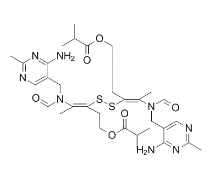All AbMole products are for research use only, cannot be used for human consumption.

Sulbutiamine shows neuroprotective effects on hippocampal CA1 pyramidal neurons subjected to oxygen-glucose deprivation. Sulbutiamine enhances electrophysiological properties such as excitatory synaptic transmissions and intrinsic neuronal membrane input resistance in a concentration-dependent manner. Sulbutiamine attenuates apoptotic cell death induced by serum deprivation and stimulates GSH and GST activity in a dose dependent manner. Furthermore, sulbutiamine decreases the expression of cleaved caspase-3 and AIF.
| Cell Experiment | |
|---|---|
| Cell lines | neuroblastoma cells |
| Preparation method | Cell viability of hippocampal slices subjected to OGD with or without sulbutiamine was determined by TO-PRO-3 iodide staining (dilution 1 : 1000). |
| Concentrations | 1, 10 and 50 μM |
| Incubation time | 15 min |
| Animal Experiment | |
|---|---|
| Animal models | Rats |
| Formulation | Arabic gum, 15% w/v |
| Dosages | 12.5 mg/kg |
| Administration | i.p. |
| Molecular Weight | 702.89 |
| Formula | C32H46N8O6S2 |
| CAS Number | 3286-46-2 |
| Solubility (25°C) | 75 mg/mL in DMSO |
| Storage |
Powder -20°C 3 years ; 4°C 2 years In solvent -80°C 6 months ; -20°C 1 month |
| Related Products |
|---|
| Myoglobin (from equine skeletal muscle)
Myoglobin is a small molecular pigment protein formed by binding globin to Heme, which can be reversibly bound to oxygen to form MbO2, MbO2 is called oxymyoglobin, and Mb is called deoxymyoglobin. Myoglobin has the role of transporting and storing oxygen in muscle cells. |
| Hemoglobin (from bovine blood)
Hemoglobin is a iron-containing protein in red blood cells with oxygen binding properties. Hemoglobin is an inducer of HO-1. Hemoglobin consits of heme, which binds to oxygen. Hemoglobin also transports other gases, such as carbon dioxide, nitric oxide, hydrogen sulfide and sulfide. |
| Diethylenetriaminepentaacetic dianhydride
Diethylenetriaminepentaacetic dianhydride (DTPA anhydride) is a bifunctional chelator whose anhydride can react with amino groups in proteins (such as lysine residues) to form stable amide bonds. Diethylenetriaminepentaacetic dianhydride (DTPA anhydride) can also bind to radionuclides to synthesize radionuclide-labeled drug conjugates (RDCs). |
| 3-Phenylthiophene
3-Phenylthiophene is a biochemical material that can be used in scientific research. 3-Phenylthiophene is a conducting polymer precursor. |
| DSPE-PEG-FA
DSPE-PEG2K-FA is a PEG derivative containing folic acid. DSPE-PEG2K-FA has a targeting effect and can bind to folic acid receptors in cancer cells. DSPE-PEG2K-FA forms micelles/lipid bilayers and can be used in research on targeted drug delivery systems. |
All AbMole products are for research use only, cannot be used for human consumption or veterinary use. We do not provide products or services to individuals. Please comply with the intended use and do not use AbMole products for any other purpose.


Products are for research use only. Not for human use. We do not sell to patients.
© Copyright 2010-2024 AbMole BioScience. All Rights Reserved.
